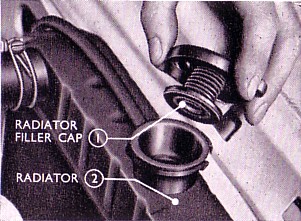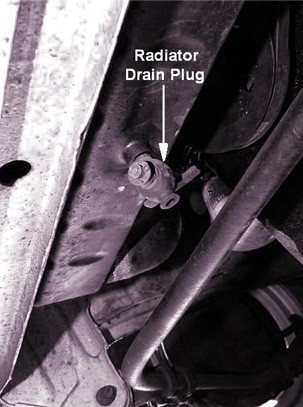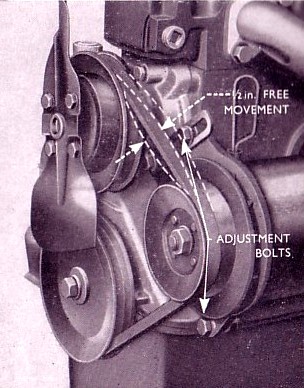You are in:

Cooling
System |

General
Maintenance - Cooling System
| The engine is
cooled by the circulation of water through the
water jackets surrounding the cylinders, cylinder
head, combustion chamber and valve seats.
Circulation is by thermo-syphon action, assisted
by a centrifugal type water pump, housed at the
front of the cylinder block. A radiator fitted with a
pressure cap forms part of the cooling system,
allowing the engine to operate at a slightly
higher temperature without boiling. Never remove
the cap if the system is hot, but first allow to
cool. Circulation is restricted during the
warming up period by means of a thermostat fitted
in the cylinder head water outlet.
|
Check the Radiator Level
- (Daily Service)
The cooling system is pressurised by means of a
spring loaded pressure radiator cap. If the
vehicle has been running and is hot, allow it to
cool down before attempting to remove the
radiator cap.Warning
– Do not remove the radiator cap when the
water is near boiling point, as this may cause
water and steam to be blown back out of the
filler neck at pressure, causing personal injury.
Remove the
radiator filler cap slowly, by pushing down
slightly and twisting it to release it. Check the
water level in the top of the radiator. Top up as
necessary with the correct anti-freeze / water
mixture, to approximately one inch (25 mm) below
the bottom of the filler to allow for expansion
of the coolant as the engine warms up. Once the
radiator has been topped, the radiator cap can be
replaced
|
 |
Draining the Cooling System
Drain taps are fitted in the radiator bottom tank
and in the cylinder block to the rear of the
generator on the left hand side of the engine.
Place a suitable bowl or bucket under the
position of the drain taps. Remove the radiator
pressure cap and the drain taps. If,
when the radiator tap has been opened and the
pressure cap is removed, water does not commence
to flow immediately, insert a piece of wire to
dislodge any sediment, which might be causing a
temporary blockage, being careful not to damage
any of the radiator fins. To drain the interior
heater system, the heater hoses must be
disconnected.
Reconnect
the heater hoses, flush the system out with clean
water and then redo the drain taps. Fill the
cooling system with an appropriate cooling system
mixture.
|
 |
Anti-Freeze
Mixture
To protect the cooling system during frosty
weather it is advisable to use an anti-freeze
mixture. Should anti-freeze mixture not be
available, drain all of the water from the
cooling system, especially if the car is to be
left standing for any considerable length of
time.Glycerine or Ethylene-Glycol are
solutions which are satisfactory for anti-freeze
purposes, but all these are organic liquids which
do not contain an anti-rust inhibitor. A suitable
anti-freeze solution may be obtained from your
Authorised Ford Dealer. NOTE
- Salt solutions etc, can be extremely harmful
and should not be used.
If immediate frost protection is
necessary, it is advisable to drain all of the
cooling water away and mix the anti-freeze with
clean water in a separate container and then add
it to the cooling system. Periodically, have the
solution tested, particularly in severe weather.
If additional coolant is required, add water and
anti-freeze solution in proportion.
The following
table has been compiled to give the percentage of
FoMoCo ME-1163-B anti-freeze required to protect
the cooling system of your car. If a heater is
fitted, remember the cooling capacity will be
increased and a proportional amount of
anti-freeze should be added as shown in the
table.

|
| Volume of
ME-1163-B in Cooling System |
Protection |
Anti-freeze
(without Heater) |
Water
(without Heater) |
Anti-freeze
(with Heater) |
Water
(with Heater) |
| 10% |
-8°C (17°F)
(15°F of frost) |
1 1/4 Imp pints
1 1/2 US pints
0.58 litres |
9 Imp pints
10.8 US pints
5.24 litres |
1 1/4 Imp pints
1 1/2 US pints
0.58 litres |
10 Imp pints
12 US pints
5.76 litres |
| 15% |
-13°C (7°F)
(25°F of frost) |
1 3/4 Imp pints
2 US pints
0.87 litres |
8 1/2 Imp pints
10.3 US pints
4.9 litres |
1 3/4 Imp pints
2 1/4 US pints
0.96 litres |
9 1/2 Imp pints
11 1/4 US pints
5.44 litres |
| 20% |
-19°C (-3°F)
(35°F of frost) |
2 1/4 Imp pints
2 1/2 US pints
1.16 litres |
8 Imp pints
9.8 US pints
4.66 litres |
2 1/4 Imp pints
2 3/4 US pints
1.3 litres |
9 Imp pints
10 3/4 US pints
5.1 litres |
| 25% |
-29°C (-20°F)
(52°F of frost) |
2 3/4 Imp pints
3 1/4 US pints
1.46 litres |
7 1/2 Imp pints
9 US pints
4.36 litres |
3 Imp pints
3 1/2 US pints
1.6 litres |
8 1/4 Imp pints
10 US pints
4.8 litres |

Check the Fan Belt
Adjustment - (1000 Mile Service)
The same V-Shaped belt drives both the generator
and water pump. The belt adjustment is correct
when, as it is pushed and pulled at a point
midway between the generator and water pump
pulleys, the total movement of the belt does not
exceed ½ in (12.7mm). A loose belt causes slip
on the pulleys, while excessive tightness results
in wear on the generator and water pump bearings
and the belt itself.To adjust the fan belt
tension, loosen the two generator lower mounting
bolts, one at the front and one at the rear, then
loosen the adjustment locking screw at the front
of the generator. This will allow the generator
to be moved outwards, the adjustment screw
sliding in the slotted arm.
When the correct
tension is obtained, tighten all three bolts
securely.
|
 |
Information taken from Various Ford
Anglia Instruction Books and Handbooks..

Warning -
The Health and Safety bit.
Please note your health may be at
risk if you do not take sensible safety
precautions. Never work under an unsupported
vehicle, do not take shortcuts. If you feel that
the task is beyond your capabilities, then employ
the services of a trained professional. The Owner
of this Website nor the author cannot be held
responsible for any accidents or injury arising
from advice given on this webpage. Safety advice
can be obtained from the RoSPA.
|




|
|

